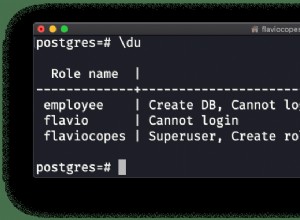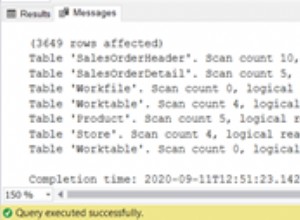Você pode usar uma cláusula with em uma atualização; você só tem que fazer isso no lugar certo:
UPDATE mytable
SET name = (WITH temp AS((SELECT 'abcd' AS oldvalue, 'defg' AS newvalue FROM dual) UNION
(SELECT .....) --About 300 lines of this, copied from Excel and then formatted into the SELECT statement
)
SELECT newvalue
FROM temp
WHERE mytable.name = temp.oldvalue);
No entanto, você provavelmente deseja atualizar apenas as linhas que existem na subconsulta temporária, portanto, você precisaria de uma cláusula where adicional:
UPDATE mytable
SET name = (WITH temp AS((SELECT 'abcd' AS oldvalue, 'defg' AS newvalue FROM dual) UNION
(SELECT .....) --About 300 lines of this, copied from Excel and then formatted into the SELECT statement
)
SELECT newvalue
FROM temp
WHERE mytable.name = temp.oldvalue)
WHERE EXISTS (WITH temp AS((SELECT 'abcd' AS oldvalue, 'defg' AS newvalue FROM dual) UNION
(SELECT .....) --About 300 lines of this, copied from Excel and then formatted into the SELECT statement
)
SELECT NULL
FROM temp
WHERE mytable.name = temp.oldvalue);
Como alternativa, use uma instrução MERGE:
merge into mytable tgt
using (WITH temp AS((SELECT 'abcd' AS oldvalue, 'defg' AS newvalue FROM dual) UNION
(SELECT .....) --About 300 lines of this, copied from Excel and then formatted into the SELECT statement
)
SELECT mytable.rowid r_id,
temp.newvalue
FROM temp
inner join mytable on mytable.name = temp.oldvalue) src
on (tgt.rowid = src.r_id)
when matched then
update set tgt.name = src.newvalue;
N.B. você precisa ingressar na tabela real na consulta de origem da instrução de mesclagem porque está tentando atualizar a coluna que está sendo unida, o que não pode ser feito em uma instrução de mesclagem - portanto, mudei a junção de mesclagem para junte-se em mytable.rowid.
Você teria que testar as duas declarações para ver qual delas tem melhor desempenho em seus dados.




